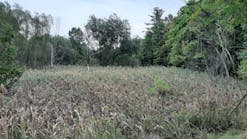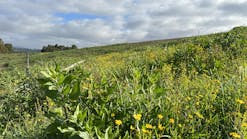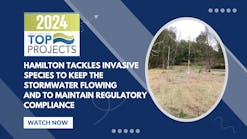Growth lies at the heart of erosion control. Certainly the most tangible growth in the practice of hydroseeding can be visible in the form of new plant stems rising toward the sun, but creative hydroseeding methods-combining mulches, techniques, and seed mixes for well-timed establishment-reflects development of another kind.
Highway construction, new residential and commercial construction, reclamation, and revegetation are some of the most common sites and uses for hydroseeding, and trends in the hydroseeding industry can be difficult to track because a variety of application techniques must pair with, and remain at the mercy of, a variety of harsh climate conditions. The US economy also positively and adversely impacts hydroseeding decisions. During tough economic times, it’s perhaps unsurprising that trends in the hydroseeding industry are largely financially driven.
“I would have to say that the biggest change in the industry lately would be the fact that private jobs are less willing to spend the extra money it takes to do the job right. This is obviously a result of the economic conditions we have been faced with for the last few years,” says Allen Stewart, vice president and project manager of High Country Hydroseeding based in Canton, NC. “This has driven our company toward the larger state and federal projects that are often backed by stimulus or aid of some kind. The few private projects that are out there are bound by tight budgets.”
The cost of hydroseeding materials’ components can also be affected by the slow economic recovery in the United States.
“The high cost of guar gum has made it cost prohibitive as an additive, and thus there has been a move to lower-cost, high-performance natural polymers such as Rantec HF5000,” says Rick Bilodeau of Ranchester, WY-based Rantec Corp.
As environmental standards tighten, contractors repeatedly are drawn to use native seed and plants onsite. Bill Agnew, president of Granite Seed and Erosion Control, based in Lehi, UT, has noticed an “upswing right now with reclamation in general” using mulch and ProMatrix. He says roadside projects use “almost all native plant materials” right now for erosion control.
However the hydroseeding trends differ by region, the importance of accurate dissemination of seed and protection of seed germination for erosion control will not fluctuate. The need for this type of growth and soil stabilization will help contractors in the industry overcome challenges and put forth deep roots for a stable future.
A Dam Raising in California
The San Vicente Dam raising project in east San Diego County, CA, is the largest dam raising in United States history, and the largest raising of a roller-compacted concrete dam worldwide. Begun in 2009, the project poses a trifecta of challenges for erosion control at the 70-acre site: access, material selection to protect water quality, and protection of an endangered species habitat.
“It’s not your typical slope stabilization. We’re raising it by 50 feet. There is so much concrete involved in something like this they tended to use some of the surrounding land to excavate a quarry to do the concrete on site,” says Russ Bergholz, P.E., PMP, senior project manager at Dudek Engineering + Environmental, which has been working at the site. “All the aggregate for the dam was all mined from the site.”
The dam raising will take place over several stages and will allow the reservoir to hold an additional 152,000 acre-feet of water. Early in the project, an environmental survey found the area that would serve as the quarry could potentially be a habitat for the rare Quino checkerspot butterfly.
“The client was concerned. The second phase is the excavation and the quarry,” says Bergholz. “If a butterfly happened to show up anywhere in the quarry, it could have huge implications on where the concrete is taken from.”
Dudek was hired to clear all vegetation, especially the shrubs that could potentially become the endangered butterfly habitat, and to stabilize the site’s slopes. The company then executed a plan to use Buffalo Grove, IL-based Profile Products’ EcoAegis Bonded Fiber Matrix (BFM) as part of the soil stabilization process on the slopes, as it worked to protect the reservoir’s water quality.
“We wanted something that would perform effectively,” says Bergholz. “Second, we wanted something that would last more than six months.”
The solution had to be organic, he explains, to minimize potential for any stormwater pollution via runoff from the 3:1 slopes onsite.
“To safely remove the butterfly from the proposed quarry site, a mitigation plan was agreed upon calling for the contractor to “˜backtrack’ all 83 acres around the back of the dam, which required bulldozers to roll over the area. All of the vegetation was either pulled up or crushed to safely remove the butterfly habitat from the construction zone and keep them at a safe distance throughout the dam-raising project. This backtracking occurred a full two years before any quarrying at the site was to begin,” according to a statement by Profile Products. “The exposed soil could cause 83 acres of sediment to wash into the drinking-water supply of 3.2 million people if not stabilized quickly. Based on city, state, and national regulations, the San Diego Water Authority required that erosion control measures adhere to strict standards based on four criteria: functional longevity, erosion protection, soil stabilization, and non-toxic ingredients.”
Sprayed on like a hydraulic mulch and 100% biodegradable, EcoAegis BFM formed a water insoluble, porous cover that bonded tightly to the soil.
“Normally, they put a seed mixture of some sort so it germinates and revegetates over six months. We didn’t want to let things grow-it’s going to be excavated in a year. We didn’t want to have any plants growing, creating a potential habitat,” says Bergholz, who adds that if new plant growth attracted the rare butterfly to the site, a new source of concrete would have to be found.
Undeniably, this would have a profound effect on the project’s budget and timetable. Soil stabilization and BFM coverage on the slopes became increasingly vital.
“Getting proper coverage of the area given the rather steep slopes was challenging. There’s access from the top and the bottom. They were basically spraying this material down the slope,” says Bergholz, who adds that the solution was mixed in a truck and pumped out with a large sprayer. “It was challenging to get a consistent layer. It was an application challenge.”
Coverage was a consideration when selecting EcoAegis BFM for the project. A cover factor of 0.05 was desired, as determined by a large-scale facility testing protocol. As part of Profile’s green design engineering philosophy, EcoAegis has passed EPA’s ecotoxicity testing protocol to show it has no dangerous chemicals, heavy metals, oil emulsion, or residues that can threaten aquatic and terrestrial life.
Silt fencing was installed at the base of the slope to control sedimentation, in combination with fiber rolls along all slopes. “They run horizontally along the contours of the slopes; every 20-foot contour there was a fiber roll,” says Bergholz, “Twenty or 30 miles of these fiber rolls (were) staked down. After they were laid down, they were sprayed. Our estimate for the clearing and erosion control work was $1.1 million. This includes $410,000 for fiber rolls and $356,000 for the BFM.”
At press time, the area has been completely excavated with the rock quarry in place; project completion is expected within two years. Revegetation at the site, where a portion of the area may remain underwater after the dam raising, will be completed by the contractor, explains Bergholz, who adds that the site has “ongoing, constant monitoring for water pollution and prevention” and that the water authority was very pleased with the result of erosion control phase of the project.
Mine Reclamation in Kentucky
Mine reclamation sites can prove a test for erosion control measures. An ongoing mine reclamation site in Pineville and Paintsville, KY, was particularly challenging because of the reach necessary to reseed the slopes. J.R. Frisbee, owner of Pioneer Seed and Supply based in Waynesville, NC, describes how his firm worked for different mining companies to bring that section of Eastern Kentucky back to its natural useful beauty during the summer months of 2005.
After topsoil was spread out over the mined area, workers had to climb the slopes of the difficult-to-reach area pulling giant hoses that would spray hydromulch and seed.
“With reclaiming those old mining sites, it’s pretty extensive. What made it amazing was these Bowie machines: You couldn’t get to every place to spray, but we had a 1,000-foot hose and used Bowie’s 3,000-gallon tank truck, and the spray distance was really good,” says Frisbee. “We averaged anywhere between 600 and 1,000 feet of hose every time we pulled a hose out.”
As state environmental requirements increase, the use of these trucks is becoming more common. For example, many Department of Transportation sites in North Carolina require 2 tons of lime per acre to be placed onsite, and this, Frisbee says, requires a larger tank like the Bowie Hydro-Mulcher Imperial 3000.
“At the Kentucky mine reclamation, the state required a specific seed mix that was native to the area, with wildlife species and erosion control first and foremost in mind,” says Frisbee, noting that the area was an elk habitat. “The root depth on the plants required provided better soil stabilization and proper vegetation for wildlife native to the area.”
Pioneer Seed and Supply selected the Bowie machine for the Kentucky site because of its pumping capability. “Not many machines can pump through the 1,000 feet of hose and still spray. The other reason is repairability of the machine,” says Frisbee. “You do not have to go back to the manufacturer to have repair done. Most of the time you can do it yourself with parts from a local hardware or auto parts store or your dealer.”
Black locust seeds were included in the seed and hydromulch mix that was sprayed onsite with the intent of establishing a tree cover.
“The site was monitored until completely covered in vegetation. At this time it is open to the general public for white-tail deer hunting and special “˜draw hunts’ for the elk,” adds Frisbee, who says that whenever he returns to the site, he finds elk using the site for “horning” the new tree growth. “It was covered enough for that.”
Canal Support in Georgia
Adding water to the equation can increase the challenge of meeting local, state, and federal requirements at most any project site. When the site is water centered with a tight timetable for groundcover success, it’s usually understood that sampling will play a major role in determining the success of the area’s erosion control plan.
During the second phase of the $12.5 million Pipemaker’s Canal project in Savannah, GA, access roads were rehabilitated during the fall of 2011 through the spring of 2012. Lifts of geotextiles and geogrid were placed on the access roads. Elkin, NC-based Carolina Precision Fibers’ hydroseeding mulch was used for topsoil stabilization and was paired with Mancos, CO-based Western Excelsior’s Double Net Excelsior for erosion control as workers battled the road failure, according to Brad McCoy, of GroGreen, based in Macon, GA. GroGreen was subcontracted by Coastal Grass and Landscape as the company worked for the DOT’s general contractor, R.B. Baker, both of the Savannah area.
“Pipemaker’s Canal is a drainage canal. All the rainwater from Savannah makes its way into Pipemaker’s Canal on its way to the Atlantic.” explains McCoy. “East Coast tides are bigger than Gulf tides. If you get a big tide and a big rain event-I’ve seen whole roads underground.
“I was down there every other week. It’s Georgia law they’ve got to have a sample after every event. Every time it would rain, there were turbidity samples taken. The Army Corps of Engineers really did a good job keeping it under control.”
The recently completed second phase was started during the heart of the Atlantic hurricane season. Workers hydroseeded the area to get groundcover germinating at the site before winter’s chill.
“This section was 3 miles of canal. So you had basically 6 miles of canal bank. The roads were failing,” says McCoy, who adds that chunks of road were actually washing way, drawing attention because of the canal’s role as the drainage access point for the city. “If something were to happen, it would be bad.”
GroGreen was familiar with Carolina Precision Fibers’ products, using them for about a decade on a variety of sites. “They’ve had a good product and a good price point,” says McCoy. The company’s hybrid mulch was used across the entire site.
Workers employed a combination of erosion control techniques at the site, pairing the combination of mulch and excelsior with a seed mix that included Bermuda and “some lovegrass with a temporary groundcover for the season on top,” McCoy says. The Western Excelsior’s Excel S-2 temporary erosion control blanket was used.
Although McCoy describes the recently completed phase two as “beautiful,” the intense attention directed toward the site left no room for setbacks from the project’s onset.
“The Corps are usually pretty tough on their requirements,” he says. “With the constant fluctuations of the water level, complete vegetation was necessary.”
Mudslide Repair in North Carolina
For all their beauty, nature’s elements can combine with the weak point of any residential site to wreak destruction. During the fall of 2010, a large mudslide in Haywood County, NC, occurred because of a combination of heavy rainfall in the area and a leaking waterline behind a retaining wall above the slide area.
“It had been leaking for some time before the rainfall,” says High Country Hydroseeding’s Stewart. The retaining wall and everything below it slid for about 500 feet, leaving a path 300 feet wide. “It took out two houses. When they put that site back, the length and width didn’t change much, but most of it was on a 1:1 slope.” Phillips & Jordan subcontracted High Country Hydroseeding to work on the project.
“We just had a small window,” says Stewart, adding that if the work wasn’t completed quickly, the seed placed on the site wouldn’t germinate after ground temperatures fell below 50 degrees. “That job was difficult anyway. The publicity was huge.”
Water quality became an issue because of the slide’s location.
“Just below that site there was some stream restoration work we did as well,” says Stewart. “The general contractor went in with their machines and cleaned up that site, using native seeds and matting.
Access was perhaps the greatest challenge. “To get to this site you have to travel the steepest state-maintained road in North Carolina-with a 3,000-gallon tank truck,” says Stewart. “We’ve been at it so long nothing comes as a surprise to us anymore.”
High Country Hydroseeding overcame the challenges in several ways. For revegetation, native grass seed was used at the site as well as crown vetch.
“Crown vetch has a tremendous root system,” says Stewart. “It tends to take over and creep and really take hold.”
Next, the company approached the access issue.
“We had to pull hose from the top and the bottom: 350 feet of hose straight up a 1:1 slope. It was a 3,000-gallon Bowie machine that allowed us to do that,” says Stewart. “The engineers had spec’ed Profile Products’ Flexterra, which is a much thicker slurry to begin with. That in combination with something straight up that far was quite difficult. The Flexterra was applied at a rate of 4,000 pounds per acre.”
Additionally, excelsior wattles were placed about every 10 feet across the slope running horizontally, he says.
The erosion control budget allotted $180,000 for seeding and watering at the site. The results have held up well throughout storm events.
“We’re very pleased, because it was in the public’s eye so much. A lot of people were concerned it might happen again, but there’s a great groundcover on it right now,” says Stewart. “It’s looking really good.”
Reaching to the Future
A call for improved testing has been raised as the hydroseeding industry advances.
“Develop test methods based on accepted science. Some of the current testing methodologies being used are unable to differentiate between low- and high-end hydraulic mulches,” says Bilodeau. “And, because there is no universally accepted test method for hydraulic mulches, manufacturers are burdened with testing at multiple facilities.”
Making use of state-of-the art technology can also help the industry grow.
“As the hydroseeding industry moves forward, I would encourage contractors and engineers to take advantage of new technology and products that are coming on the market,” says Stewart. “An example would be the use of PAM. It has proven to be a great product in the battle against erosion.”
Finally, one industry insider believes product advancement should help the market take root and flourish.
“I think they need to continue to be innovative-make better products and more cost-effective products. It’s the way of the future. They’ve got a lot of good products and competitive products, they just need to continue to be innovative,” says Agnew. “Longevity is very important here in the West.”
Products and materials have to be able to produce germination and growth while withstanding a broad variety of harsh weather conditions. “It may take multiple growing seasons to get (plants) growing on a slope,” says Agnew. “The last thing you want is a material that’s short lived.”






